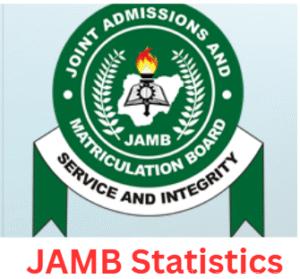Every year in Nigeria, over a million students register for the Unified Tertiary Matriculation Examination (UTME) conducted by the Joint Admissions and Matriculation Board (JAMB). But only a fraction of them get admitted into their chosen universities, polytechnics, or colleges of education.

These numbers aren’t just digits, they tell real stories of competition, inequality, policy gaps, and hard decisions. If you’re preparing for JAMB or just curious about how the system works, this comprehensive breakdown of JAMB statistics will show you what’s really happening behind the scenes.
What Exactly Are JAMB Statistics?
JAMB statistics are yearly figures that show how the UTME process unfolded, how many candidates registered, how they scored, the courses they applied for, and the schools they chose. They also reveal how many actually got admission.
Instead of guessing what’s popular or competitive, these stats give you real facts. They show how tough certain courses are, which universities attract the most interest, and how performance changes from year to year. For students, parents, and anyone involved in the admission process, JAMB statistics are a powerful guide, not just numbers, but clues that help with better planning and smarter choices.
Why JAMB Statistics Matter
To many students, JAMB is just a yearly exam, and the numbers behind it might seem like something only officials or researchers should worry about. But in reality, JAMB statistics are one of the most important tools for any serious candidate. These figures give you insight into how the system works, who you’re competing against, and what you can do to increase your chances of admission. Here’s why JAMB statistics should matter to you:
1. They help you understand the level of competition: When you see that hundreds of thousands of students applied for the same course you’re considering; like Medicine, Law, or Nursing, it puts things in perspective. It’s not just about passing the exam anymore; it’s about knowing how tight the race really is, so you can plan smarter.
2. They help you choose wisely: Let’s say you wanted to apply for University of Lagos (UNILAG), but JAMB stats show it’s one of the most applied to universities in Nigeria. That doesn’t mean you shouldn’t apply, it just means you should know what you’re walking into. Maybe consider a solid backup school that offers your course but gets fewer applicants.
3. They show you which courses are oversubscribed: Courses like Medicine and Law are always packed, but JAMB data might show you that other great courses like Physiotherapy, Public Health, or Medical Laboratory Science have fewer applicants and still lead to strong careers. That’s a major advantage if you’re flexible and strategic.
4. They help you predict admission chances: If you know the number of slots available versus the number of applicants, you can calculate your odds. It’s not just about hope, it’s about having facts that help you make decisions with your head, not just your heart.
5. They guide you on what to improve: If most candidates scored below 200 in a given year, and you aim higher, you already stand out. JAMB performance stats let you gauge how much work you need to put in to beat the average and stand out to universities.
JAMB statistics aren’t just for headlines, they’re for strategy.
If you take them seriously, they can be the difference between guessing and making informed, confident choices.
JAMB Statistics for Nigerians
1. Total Number of Registered Candidates (2020–2025): JAMB has consistently recorded high numbers of applicants, but 2025 officially set a new record with 2.03 million registered candidates. Here’s how the last six years compare:
- 2020: ~1.94 million
- 2021: ~1.38 million (COVID-19 impact)
- 2022: ~1.76 million
- 2023: ~1.8 million
- 2024: ~1.98 million
- 2025: 2.03 million
This steady rise is driven by Nigeria’s rapidly growing youth population, one of the youngest in the world, as well as high societal expectations around university education. With fewer students considering polytechnics, colleges of education, or skilled vocational paths, the pressure on university admissions keeps increasing. Also, many of those sitting for JAMB each year are not first timers, some are reapplying after previous setbacks, or trying to change courses or institutions. This repeat candidate effect adds to the yearly totals. Yet, despite the increasing number of applicants, admission capacity has not grown at the same pace, creating a wide gap between demand and available university slots.
2. Admission Capacity vs. Number of Applicants: In 2025, over 2 million candidates registered for the UTME, but Nigeria’s entire tertiary system; universities, polytechnics, and colleges of education can only accommodate an estimated 850,000 to 1 million students per year. That means at least 1 million qualified candidates will likely miss out on admission this cycle. The competition is especially tough for high demand courses. For instance, Medicine, Nursing, and Law each attract over 100,000 applicants nationwide, but many of these courses have just a few thousand slots available sometimes less. This growing gap between candidates and available spaces highlights why strategic planning is crucial when selecting courses and institutions
3. Most Competitive Courses in 2025: While JAMB does not release exact figures for every course annually, previous data and consistent patterns reveal which courses remain the most competitive. In 2023, JAMB confirmed that;
- Medicine and Surgery had over 452,000 applicants, competing for just under 80,000 slots nationwide.
- Engineering had 163,123 applicants across various disciplines, with about 68,896 slots available.
- Law attracted 81,653 candidates, but fewer than 9,000 spaces were open in 2022.
These numbers help paint a clear picture of how competitive certain courses have become. Given that 2.03 million candidates registered for UTME in 2025, we can reasonably estimate this year’s distribution using known trends:
- Medicine and Surgery estimated 450,000+ applicants
- Nursing Science likely 300,000+, due to rising demand in health related fields
- Law around 180,000+
- Engineering (all types combined) about 160,000+
- Business Administration & Accounting each attracting roughly 120,000+ candidates
These figures show just how intense the competition is especially for professional courses. For many of these programs, universities only offer a few thousand slots per year. If you’re aiming for one of these fields, scoring high is just the beginning. You’ll also need smart course combinations, strong post UTME performance, and backup options in less oversubscribed institutions or programs.
Note: These figures are estimated based on available data from previous years and current registration trends.
4. Most Applied For Universities in Nigeria (2025): According to the JAMB Policy Meeting results for 2024/2025, these universities received the highest volume of first choice applications:
- University of Ilorin (UNILORIN) 64,143 applicants
- Lagos State University (LASU) 62,601 applicants
- University of Lagos (UNILAG) 59,105 applicants
- Federal University Oye-Ekiti (FUOYE) 55,481 applicants
- Nnamdi Azikiwe University (UNIZIK) 54,495 applicants
- University of Ibadan (UI) 50,598 applicants
- University of Nigeria, Nsukka (UNN) 48,544 applicants
- University of Benin (UNIBEN) 47,811 applicants
- Obafemi Awolowo University (OAU) 44,155 applicants
- University of Port Harcourt (UNIPORT) 43,376 applicants
That’s more than 60,000 first choice candidates for UNILORIN alone, despite admission intake usually accounting for only 5–10% of that number. These trends demonstrate the fierce competition at these institutions, especially for popular programs like Medicine, Engineering, and Law.
5. Gender Distribution: In the 2024 UTME, JAMB recorded a near-even split in gender representation:
- Female candidates: 1,007,275 (50.6%)
- Male candidates: 982,393 (49.4%)
This marked a notable shift, with more female candidates registering for the exam than males, for the first time in recent years. Although JAMB hasn’t released the full gender breakdown for 2025 yet, early trends suggest a similar pattern, with gender parity likely continuing this year. However, gender skews remain within specific fields. Courses like Nursing, Education, and Mass Communication are still largely dominated by women, while Engineering, Computer Science, and Physics based disciplines remain male heavy.
Note: The 2025 gender breakdown will be updated once officially released by JAMB.
6. State by State JAMB Registration: As of now, JAMB has not released the full state-m by state breakdown for 2025. However, trends from the 2024 UTME offer a reliable guide to what we can expect this year. In 2024, the states with the highest number of registered candidates were:
- Oyo – 123,636
- Ogun – 114,435
- Osun – 110,854
- Imo – 102,741
- Delta – 91,344
Meanwhile, the states with the lowest registration numbers included:
- Zamfara – 9,473
- FCT-Abuja – 8,020
- Bayelsa, Sokoto, and Kebbi also ranked among the bottom tier.
These variations reflect factors like population size, literacy rates, education infrastructure, and awareness of tertiary opportunities. While the exact numbers for 2025 are yet to be published, early projections suggest that the same states will likely maintain their positions at both ends of the spectrum.
Note: This breakdown is based on 2024 JAMB data and trends. The official 2025 state by state figures will be updated once released by JAMB.
7. Score Performance & Distribution: According to official JAMB data for the 2025 UTME;
- 565,988 candidates (29.3%) scored 200 and above (out of 400), showing an improvement over previous years.
- 1,365,479 candidates (70.7%) scored below 200, though this is a better outcome compared to 2024, when 76% scored below that mark.
- 17,025 candidates (0.88%) scored 300 and above, the highest percentage since the adoption of CBT in 2013.
- 117,373 candidates (6.08%) scored between 250 and 299, up from 4.18% in 2024.
Much of this improvement is linked to a resit exercise for candidates affected by technical issues at CBT centres, which gave over 200,000 additional candidates a chance to cross the 200 mark cutoff. These statistics reveal a positive trend in high end performance, though the majority of candidates still fall below the competitive threshold for highly subscribed courses and institutions.
Why Many Candidates Don’t Get Admitted
With over 2 million candidates registered for the 2025 UTME and fewer than a million slots available across universities, polytechnics, and colleges, it’s no surprise that many students don’t make it past the admission stage. But the issue isn’t just the numbers, it’s also what candidates do (or don’t do) during the process. Here are some of the most common reasons why thousands of qualified candidates still miss out:
1. Unrealistic Course or University Choices: Many students chase highly competitive courses like Medicine, Law, or Engineering in top tier schools, without considering alternatives. Choosing a course with 80,000 applicants and only 2,000 slots automatically puts you in a high-risk category.
2. Low UTME or Post UTME Scores: Scoring below 200 doesn’t automatically mean failure, but for courses with high cut offs, anything below 250 might not be enough. Even with 200+, some departments use higher internal benchmarks, and not meeting those means you’re out.
3. Wrong Subject Combinations: This is one of the easiest mistakes to avoid, yet it disqualifies thousands every year. For example, applying for Medicine without Physics or for Law without Literature in English can make your application invalid, no matter your score.
4. Incomplete O’Level Requirements: Even with a high UTME score, failing to meet the required five credits in your WAEC, NECO, or NABTEB including English and Mathematics will block your admission.
5. Failure to Upload or Update Results: Some students forget to upload their O’Level results to the JAMB CAPS portal or do so too late. If your result isn’t available when schools are compiling lists, your name won’t be considered, even if you passed everything.
6. Ignoring Schools with Available Slots: Some institutions don’t fill up their quotas every year, but many candidates overlook them. By applying only to popular schools, students miss out on real opportunities in less competitive but equally accredited institutions.
Important Note: This article was created using the most recent information available from JAMB and other reputable education sources. While some 2025 details such as course specific applicant numbers and state registration data, are still being finalized, everything included here is based on verified reports, past trends, and logical projections. Where official updates haven’t been released yet, we’ve made thoughtful estimates to help students better understand the admission landscape and make informed choices. This guide is designed to support you with useful context and direction. However, we always recommend double checking admission requirements and updates directly through JAMB or your preferred institution when making final decisions.
Conclusion
Every year, millions of students write the UTME with big dreams and only a portion get admitted. These JAMB statistics aren’t meant to discourage you. They exist to inform, guide, and prepare you for what’s ahead. Whether you’re aiming for Medicine at UNILAG or a solid science course in a state university, the numbers help you plan your next move with confidence. They show you where the pressure is, where opportunities lie, and what mistakes to avoid. Understanding the stats means you’re no longer just another number in the system, you’re a student making informed, strategic choices. So don’t just study hard, plan smart. Use what you now know to increase your chances, stay focused, and take control of your admission journey.
Frequently Asked Questions (FAQs)
1. What do JAMB statistics actually mean?
They’re the breakdown of what happened during a JAMB admission year, how many people applied, how they scored, which courses were most popular, and how many got admitted. It helps paint the big picture of what students are facing.
2. Can I trust the numbers in this article?
Yes. We’ve used the latest confirmed data available from JAMB, and where full 2025 stats aren’t out yet, we clearly mentioned where estimates were used, based on past results and official trends. The goal is to give you useful insights, not guesses.
3. Why do some students still miss admission, even with good scores?
Because scoring high is just one part of it. Other factors like choosing a very competitive course, not having the right subject combination, or forgetting to upload your O’Level results can block your chances, no matter your UTME score.
4. What are the most competitive courses this year?
Medicine, Nursing, Law, and Engineering are still at the top. They get tons of applicants every year but have limited admission slots, so they’re tough to get into.
5. What if I didn’t score 200, do I still have a chance?
Yes, you do. Many schools, especially polytechnics and colleges of education, accept scores between 160 and 180, depending on the course. You just need to look at the right places.
6. How does knowing these stats actually help me?
It helps you make better decisions. You’ll understand which schools are crowded, what courses are in demand, and where you might have a stronger shot at getting admitted.
7. Where can I get the latest and official information?
The most accurate updates come straight from JAMB’s official website: www.jamb.gov.ng. You can also check your school of choice for any extra requirements.

